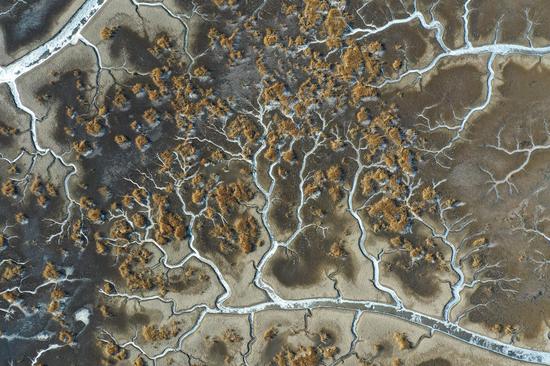
Technicians install turbines of a wind farm in Hinggan League, Inner Mongolia autonomous region, in December. (PHOTO by WANG ZHENG/FOR CHINA DAILY)
Big investments in wind, photovoltaic projects help make nation leader in reusable utilities
The huge Xinjiang Uygur autonomous region, with vast desert expanses of strong winds and intense sunshine, has become a pioneer in the country's new energy drive. It is turning its natural endowments into power for a greener future.
Xinjiang's renewable energy production reached 37.22 billion kilowatt-hours in 2022, up 25.5 percent year-on-year, according to the Xinjiang branch of the State Grid Corp of China, the country's largest State-owned utility company.
Clean energy accounted for around 30 percent of the total power transmitted to 20 other Chinese provinces, autonomous regions and municipalities, including Henan, Anhui and Shandong provinces. It has effectively balanced power demand and supply in the country, the branch said.
The region transmitted a record high of more than 125.8 billion kWh of electricity to other parts of the country last year, up 2.77 percent year-on-year, it said.
Xinjiang's new energy push is only part of the country's accelerating shift from fossil fuels to clean energy, as it vows to peak carbon dioxide emissions by 2030 and achieve carbon neutrality by 2060.
China plans to speed up the construction of solar and wind power generation facilities in the Gobi Desert and other arid regions amid efforts to boost renewable power, according to a statement jointly released by the National Development and Reform Commission and the National Energy Administration in 2022.
China had launched the first phase of wind and solar power projects by the end of 2021, comprising a total of 100 gigawatts of wind and solar power capacity in desert areas that cover 19 provinces. The second phase will focus on the Gobi and other sandy and rocky regions, with an estimated investment of up to 3 trillion yuan ($442 billion) in related industries, it said.
Most of the projects will be located in the northwestern parts of China that have vast renewable energy resources, including the Inner Mongolia, Ningxia Hui and Xinjiang Uygur autonomous regions. Local governments are not only transforming their advantages in local resources into an economic advantage, but also ensuring a sufficient power supply for the country.
Market observers and industry experts expect that China's attempt to greatly expand its wind and solar power capacity will further facilitate the country's low-carbon energy transition and ensure domestic energy security.


















































 京公網安備 11010202009201號
京公網安備 11010202009201號